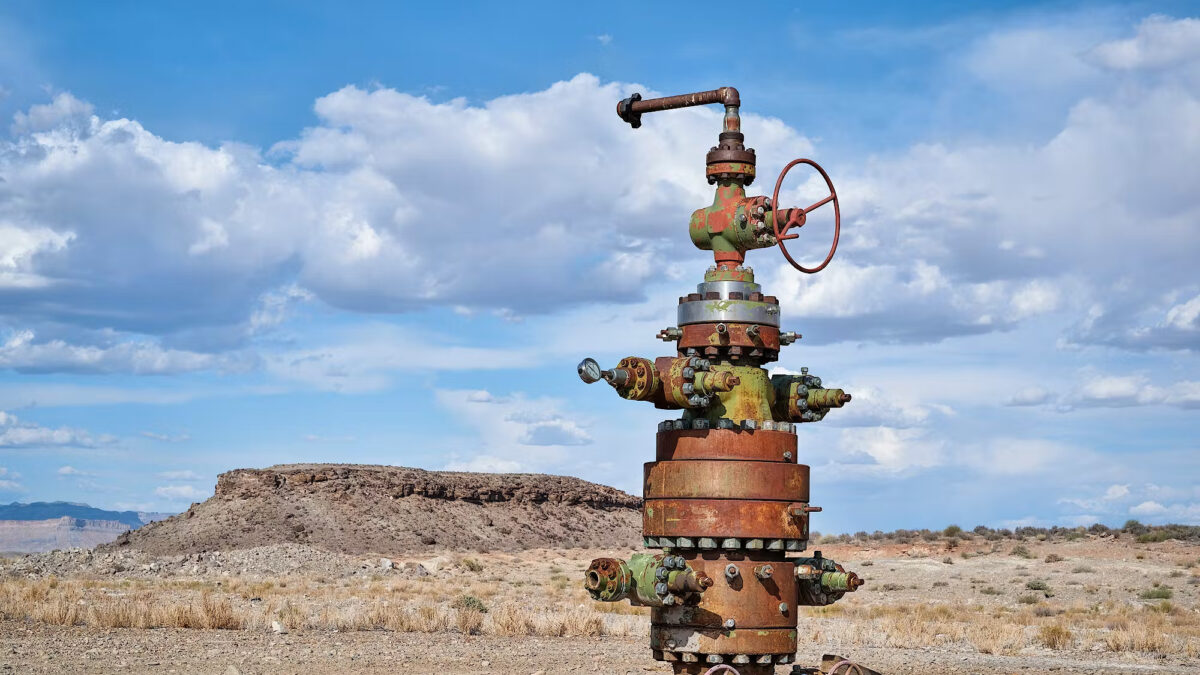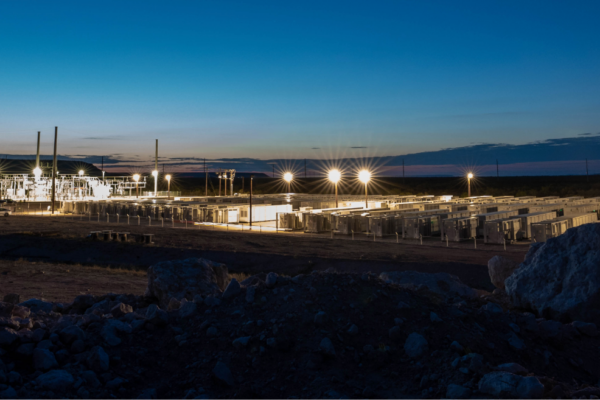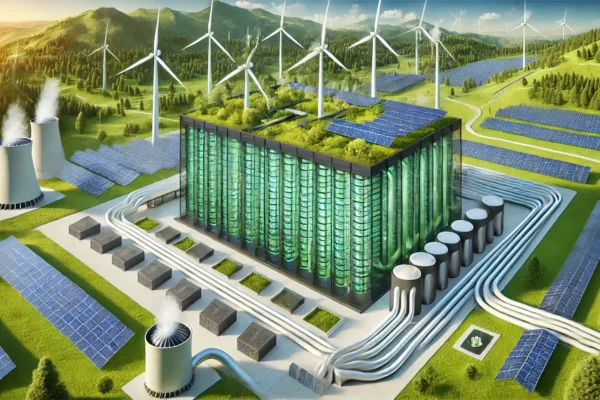“Cutting methane emissions is the single fastest, most effective way there is to slow the rate of global warming right now.” – Ilissa Ocko, Senior climate scientist, Environmental Defense Fund
Since the first American oil well was drilled in Titusville, Pennsylvania in 1859, the Oil and Gas (O&G) industry has drilled more than 3.7 million wells across the United States. More than half of these wells remain unplugged, indefinitely leaking methane into our atmosphere—not to mention toxic fumes like arsenic, formaldehyde, and benzene.
Although O&G well operators are now required to properly plug and abandon (P&A) wells before leaving wellsites, it’s often more economical to simply leave the well unplugged, idle, and thus leaking methane, than it is to deal with the costly engineering process of sealing a well that extends thousands of feet below the surface. Leaking wells are particularly expensive to seal, and many existing intervention methods are ineffective and costly—sometimes totaling millions of dollars for a single well.
Finding an economic and effective solution to seal O&G wells is essential in order to safely decommission our dirtiest energy assets and protect our atmosphere from their emissions.
Valo’s latest portfolio company BioSqueeze is doing just that.
The Problem: End-of-Life for O&G Wells
Most oil wells are, relatively speaking, fairly simple to plug. As long as the original cement around the well casing is intact, an operator ‘just’ needs to fill the main borehole with a series of cement and cast iron plugs to decommission the well.
The reality, however, is that decades-old cement often cracks or debonds from the casing under the intense and fluctuating pressures thousands of feet below ground. Gaseous methane begins to leak through these channels, escaping around a traditional plug into either the atmosphere or the surrounding groundwater.
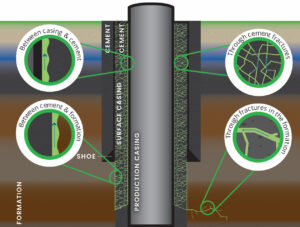
A range of solutions already exist to seal leaks during the decommissioning process. The problem is that none of them work particularly well. The first attempt often involves an operator trying to squeeze more cement; but simply adding more cement to cracks in existing cement rarely works. Either the particulate is too big to enter the cracks or the gas pressure cuts right through it while it’s setting. The next attempt might be a casing expander tool; these machines do exactly what they sound like, and try to compress cracks shut by forcing out the entire well casing. Often, however, this does not work and in some cases just creates even more cracks. After other attempts fail, operators will sometimes try polymer and epoxy resins, but they too have difficulty accessing small channels, can pose toxic environmental hazards themselves, and can complicate the situation significantly as they are extremely difficult to remove when they fail.
According to Valo’s diligence, O&G operators are known to have spent millions of dollars trying to plug a single well, attempting the same standard set of solutions over and over again. This calls to mind a certain Albert Einstein quote about the definition of insanity.
In the United States alone, more than 40,000 wells are plugged each year. This sounds like a high number, yet roughly 10 to 20 thousand new wells are drilled each year and 2.2 million still remain unplugged and inactive/abandoned. To accelerate the transition to a clean economy, we need to improve the rate and economics with which we shutter idle wells that continue to pollute our environment. And we can’t do that with incumbent technology.
The Solution: Meet BioSqueeze
Based in Butte, Montana, a town with a rich history of mining, drilling, and critical resource extraction, BioSqueeze has pioneered a novel solution to permanently seal the most problematic O&G wells using biomineralization.
The team, led by CEO Mark Ranali and co-founders Randy Hiebert and Robert Hyatt, has developed a proprietary microbial solution that can be pumped into the smallest of cracks before biomineralizing into calcium carbonate. With over 100 wells already sealed at a success rate of over 95%, BioSqueeze is fundamentally altering the economics for O&G’s ability to quickly and responsibly decommission their most polluting wells.
Based on research conducted at Montana State University, BioSqueeze pairs proprietary microbiology with immense industry knowledge. Their fluids can penetrate micro-annuli as small as one micron wide, and their operating team has the know-how to execute in even the most difficult oil wells thousands of feet below the surface.
BioSqueeze is initially targeting wells with sustained casing pressure (SCP) or surface casing vent flow (SCVP)—industry terminology to describe common symptoms of wells that lack integrity and are leaking methane. These are both the most environmentally damaging and expensive wells to remediate. The company’s effective and economical solution is a compelling business case for O&G operators.
Usually, that remediation process begins with a cement bond log (see image below) to locate the cracks in the well. Once a BioSqueeze pump truck is on site, the specially-designed, precision pumping system squeezes living microbes into networks of cracks for up to 36 hours, carefully fluctuating pressure to maximize the seal between calcium carbonate and cement.
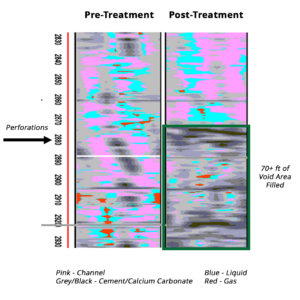

When BioSqueeze leaves the site, those living microbes have—in the same way that stalactites form—mineralized into stone, completely stopping any leaking methane.
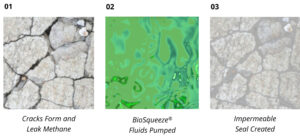
BioSqueeze’s Series A, which Valo led, is an essential step in scaling beyond the early adopters. The team will be expanding their fleet of pumping trucks—to have at least one stationed in every major O&G basin in North America—and rolling out their remote operations capability, to manage each well site from the Butte HQ.
This expansion couldn’t happen at a better time, as BioSqueeze is poised to capture significant revenue from the American government’s $4.7 billion orphaned well cleanup program. That’s not to mention the hundreds of millions of dollars deployed by states for well remediation, the methane emissions fee introduced by the Inflation Reduction Act, or the new requirements on O&G operators to monitor and mitigate any methane leaks. Methane emissions are finally receiving the attention that they deserve—from both the government and the venture community—and now we need to supercharge the best-in-class companies eliminating those emissions.
Why Valo invested in BioSqueeze
Over the last three years, hundreds of millions of venture dollars have gone into the methane monitoring space. We are getting better and better at detecting methane leaks from the O&G sector, but the available options for speedy and complete mitigation are relatively few.
At Valo, we believe that preventing methane emissions is one of the most powerful levers to slow climate change, especially considering the time value of carbon, or in this case, methane. Because methane’s 20-year warming potential is more than 80-times carbon dioxide’s, even small mitigations can have big impacts. And BioSqueeze’s potential mitigation is not small:
The EPA estimates that abandoned O&G wells in the United States alone emit about 295,000 tons of methane each year, the 20-year equivalent of 24.78 million tons of carbon dioxide. The upper-bound of their 95% confidence interval, however, is 217% higher, and most research points to continued undercounting of methane emissions.
Without BioSqueeze’s intervention, these notoriously hard-to-plug wells would continue warming the planet for years to come.
The negative impact of leaking wells doesn’t stop with the atmosphere. A host of news stories document the personal and environmental tragedy inflicted by wells leaking into the surrounding soil and water. BioSqueeze, unlike alternative solutions like cement or resin, is completely natural and poses no risk to the aquifers and soil we are trying to protect.
On all counts, BioSqueeze fills a major need in the responsible decommissioning of O&G wells. The clean energy transition is not just a matter of installing more renewable assets, but making sure we safely and properly decommission old assets.
Valo is excited about the opportunity BioSqueeze is presented with—to capture a burgeoning market and eliminate fugitive methane emissions.
Facilitating the larger energy transition
In Valo’s assessment of the energy sector, it appears likely that the O&G industry will remain a part of the energy mix in the medium to long term. To ignore the industry and its employees would be inefficient; to ignore its negative externalities would be ineffective.
With our investment in BioSqueeze, we aim to reduce the negative impact of existing O&G operations as we simultaneously usher in the clean energy transition by decommissioning their most polluting assets.
The BioSqueeze team has the industry experience and technical expertise to accomplish its goals, and Valo is thrilled to be a partner and advisor in their expansion.
To learn more about Valo’s portfolio companies, please visit our website.
